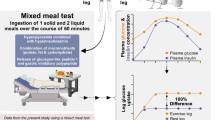Abstract
Background and aims
Variations in genes involved in energy expenditure affect aerobic exercise efficiency, but it remains unclear whether the effect of aerobic exercise on adipocytokines is modified by the obesity-associated genotypes in the uncoupling protein 2 gene (UCP2). The purpose of this study was to assess whether genetic variation in UCP2 may affect exercise-mediated changes in adipocytokines and markers of metabolic syndrome in postmenopausal obese women.
Methods
Forty-two sedentary postmenopausal obese women (age 52.74 ± 6.39 years) participated in this study. Participants were encouraged to train for 3 days a week, for 6 months, for 60 min per session of treadmill walking/running at 60 % \( \mathop V\limits^{ \cdot } {\text{O}}_{ 2} {\text{R}} \). Subjects were genotyped for the 45-bp insertion/deletion (I/D) polymorphism in the 3′-untranslated region (UTR) of UCP2.
Results
Among the subjects, 23 (57.1 %) and 19 (42.9 %), were deletion homozygotes (DD) and ID heterozygotes, respectively. For DD homozygotes, body weight, body mass index (BMI), % body fat, and waist circumference, and body weight, BMI, and waist circumference of ID heterozygotes, were significantly decreased after the exercise program. There were no significant changes in metabolic markers in individuals with the ID genotype, whereas insulin and HOMA-IR in individuals with the DD genotype were significantly decreased after the exercise program. In DD homozygotes, but not in ID heterozygotes, adiponectin was significantly increased, and leptin, TNF-α, and IL-6 were significantly decreased after exercise training.
Conclusions
Exercise-mediated changes in insulin resistance and adiponectin levels may be affected by genotypes in the 3′UTR I/D polymorphism in UCP2 in postmenopausal obese women.

Similar content being viewed by others
References
Kahara T, Takamura T, Hayakawa T, Nagai Y, Yamaguchi H, Katsuki T, Katsuki K, Katsuki M, Kobayashi K (2002) Prediction of exercise-mediated changes in metabolic markers by gene polymorphism. Diabetes Res Clin Pract 57(2):105–110
Bouassida A, Chamari K, Zaouali M, Feki Y, Zbidi A, Tabka Z (2010) Review on leptin and adiponectin responses and adaptations to acute and chronic exercise. Br J Sports Med 44(9):620–630
Haper M (1997) Obesity research continues to spring leaks. Clin Invest Med 20:239–244
Schrauwen P, Troost FJ, Xia J, Ravussin E, Saris WH (1999) Skeletal muscle UCP2 and UCP3 expression in trained and untrained male subjects. Int J Obes Relat Metab Disord 23(9):966–972
Nordfors L, Heimbürger O, Lönnqvist F, Lindholm B, Helmrich J, Schalling M, Stenvinkel P (2000) Fat tissue accumulation during peritoneal dialysis is associated with a polymorphism in uncoupling protein 2. Kidney Int 57(4):1713–1719
Lee YH, Kim W, Yu BC, Park BL, Kim LH, Shin HD (2008) Association of the ins/del polymorphisms of uncoupling protein 2 (UCP2) with BMI in a Korean population. Biochem Biophys Res Commun 371(4):767–771
Morita E, Taniguchi H, Sakaue M (2009) Trp64Arg polymorphism in beta3-adrenergic receptor gene is associated with decreased fat oxidation both in resting and aerobic exercise in the Japanese male. Exp Diabetes Res 605(139):1–5
Cortright RN, Zheng D, Jones JP, Fluckey JD, DiCarlo SE, et al (1999) Regulation of skeletal muscle UCP2 and UCP-3 gene expression by exercise and denervation. Am J Physiol 276(1Pt1):E217–221
Marti A, Corbalán MS, Forga L, Martinez-González MA, Martinez JA (2004) Higher obesity risk associated with the exon-8 insertion of the UCP2 gene in a Spanish case-control study. Nutrition 20(6):498–501
Yanovski JA, Diament AL, Sovik KN, Nguyen TT, Li H, Sebring NG, Warden CH (2000) Associations between uncoupling protein 2, body composition, and resting energy expenditure in lean and obese African American, white, and Asian children. Am J Clin Nutr 71(6):1405–1420
Ricquier D (2005) Respiration uncoupling and metabolism in the control of energy expenditure. Proc Nutr Soc 64(1):47–52
Matthew DR, Hosker JP, Rudenski AS, Naylor BA, Treacher DF, Turner RC (1985) Homeostasis model assessment: insulin resistance and beta-cell function from fasting plasma glucose and insulin concentrations in man. Diabetologia 28:412–419
Lee HJ, Ryu HJ, Shin HD, Park BL, Kim JY, Cho YM, Park KS, Song J, Oh B (2008) Associations between polymorphisms in the mitochondrial uncoupling proteins (UCPs) with T2DM. Clin Chim Acta 398(1–2):27–33
Evans D, Minouchehr S, Hagemann G, Mann WA, Wendt D, Wolf A, Beisiegel U (2000) Frequency of and interaction between polymorphisms in the beta3-adrenergic receptor and in uncoupling proteins 1 and 2 and obesity in Germans. Int J Obes Relat Metab Disord 24(10):1239–1245
Walder K, Norman RA, Hanson RL, Schrauwen P, Neverova M et al (1998) Association between uncoupling protein polymorphisms (UCP2-UCP3) and energy metabolism/obesity in Pima Indians. Hum Mol Genet 7(9):1431–1435
Chevillotte E, Giralt M, Miroux B, Ricquier D, Villarroya F (2007) Uncoupling protein-2 controls adiponectin gene expression in adipose tissue through the modulation of reactive oxygen species production. Diabetes 56(4):1042–1050
Zhou M, Xu A, Tam PK, Lam KS, Chan L, Hoo RL, Liu J, Chow KH, Wang Y (2008) Mitochondrial dysfunction contributes to the increased vulnerabilities of adiponectin knockout mice to liver injury. Hepatology 48(4):1087–1096
Acknowledgments
This work was supported by the Dankook University Research fund of 2013 (BK21+).
Conflict of interest
On behalf of all authors, the corresponding author states that there is no conflict of interest.
Author information
Authors and Affiliations
Corresponding author
Rights and permissions
About this article
Cite this article
Lim, KI., Shin, YA. Impact of UCP2 polymorphism on long-term exercise-mediated changes in adipocytokines and markers of metabolic syndrome. Aging Clin Exp Res 26, 491–496 (2014). https://doi.org/10.1007/s40520-014-0213-3
Received:
Accepted:
Published:
Issue Date:
DOI: https://doi.org/10.1007/s40520-014-0213-3




